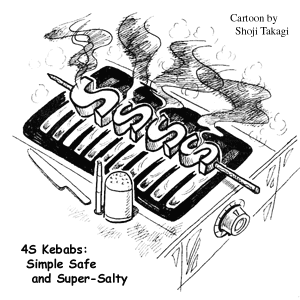
Toshiba hopes to install a 10 MWe sodium-cooled modular reactor in the town of Galena (population of about 700) on the Yukon River in Alaska. On 14 December 2004 the Galena City Council passed a resolution supporting the construction and operation of a 4S reactor, so named on the grounds that it is claimed to be super-safe, small and simple.
The 4S was developed jointly by Toshiba and the Central Research Institute of Electric Power Industry. Newspaper articles say the fuel will be enriched uranium, but other literature suggests that the fuel will be 24% plutonium. We contacted Toshiba to clarify this point and were told that the reactor is still under development, so no precise figures can be given. However, since 4S is a fast reactor, if it uses enriched uranium the enrichment level would need to be quite high. For example, two fast reactors currently operating on uranium fuel use an enrichment of 20% to 25% (David Albright, ISIS, October 8, 2004). Given that the core will not be changed during the reactor's lifetime, we would expect the level of enrichment to be at least this high. Criticality is maintained by a neutron-reflecting shield, which slowly slides over the core as the fuel is burned over the predicted 30-year life of the reactor.
There are environmental problems associated with diesel generators and the town hopes that for them the nuclear option will be more environmentally benign. Toshiba hopes to install the reactor free of charge as a demonstration project. Galena will only have to pay operating costs (mostly arising from the need to employ security guards), but estimates suggest that in this remote region 4S would be cheaper than the alternatives anyway. Currently diesel fuel is transported by river barge, but this is only possible in the summer months when the Yukon isn't frozen. The fact that 4S doesn't require refueling is therefore a major advantage.
Before the project can proceed, the design must be certified by the US Nuclear Regulatory Commission. Toshiba hopes to submit an application for provisional certification this summer. If it succeeds in its application for NRC certification, Toshiba believes that there will be opportunities for sales worldwide. However, there are still many hoops that Toshiba has to go through before the project can proceed. For a start, Toshiba will have to prove that it has solved the problem of devastating accidents resulting from sodium leaks (compare the Monju FBR accident in 1995). This will be particularly challenging given that the reactor is supposed to operate without maintenance.
Using plutonium or uranium enriched to around 20% or 25% raises proliferation issues. Despite claims that 4S is proliferation resistant, using plutonium or uranium means that there must be supplies of this type of fuel. Creating a new market for this type of fuel will inevitably create additional proliferation risks. There is also the nuclear waste problem, of course. Regardless of whether this burden is borne by Galena, there is still no solution to the problem of nuclear waste.
Significant opposition to the plan has already emerged. Platts Nuclear Flashes (2/14/2005) reported that one of the member tribes of the Yukon River Inter-Tribal Watershed Council (an organization of 58 indigenous governments committed to protecting the Yukon River Watershed) has passed a resolution calling for a moratorium on experimental reactors and radioactive waste. Other tribes were in the process of drafting resolutions. Apparently they appealed to NRC about the matter, but NRC responded that it cannot kill a reactor project if it meets agency regulations.
If the reactor is installed, which probably won't be before 2010, it will have the potential to supply much more electricity than Galena now uses. Proponents say it could be used to produce hydrogen. Galena could become a focus for the much discussed hydrogen economy. For the moment, however, the town is not getting carried away. According to Galena City Manager, Marvin Yoder, the council could stops the project simply by taking no action at any of the biannual review points. Let's hope so, but in the meantime this is a case worth watching, particularly considering the risk that these small reactors might proliferate.
Philip White (NIT editor)
Return to NIT 105 contents

